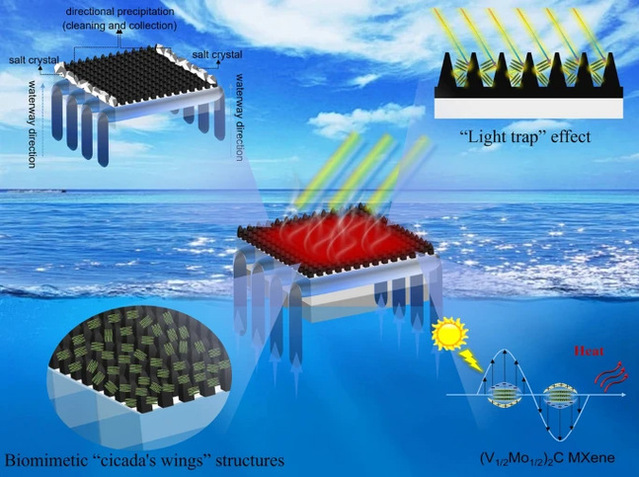
A recent study by Prof. Hongzhi Cui’s team from the School of Materials Science and Engineering has made significant progress in solar-driven seawater desalination. The research, titled Biomimetic Micro-Nanostructured Evaporator with Dual-Transition-Metal MXene for Efficient Solar Steam Generation and Multifunctional Salt Harvesting, was published in the internationally renowned journal Nano-Micro Letters.
Research Context
Solar-driven interfacial evaporation is emerging as a promising solution to global freshwater scarcity due to its clean and sustainable nature. However, achieving a balance between high evaporation rates, efficient salt harvesting, and multifunctional adaptability in evaporators remains a critical challenge. MXene, a novel 2D material with abundant surface functional groups, corrosion resistance, antibacterial properties, and tunable composition/bandgap/work function, offers unique advantages for multifunctional applications in complex marine environments. Nevertheless, harsh conditions such as intense solar irradiation, weathering, low-temperature icing, dust accumulation, and biofouling still severely degrade evaporator efficiency
To address these challenges, Prof. Hongzhi Cui’s team drew inspiration from the superhydrophobic anti-fouling properties of cicada wings to design and construct a biomimetic microstructured photothermal superhydrophobic composite ceramic membrane. The team employed a dual-transition-metal (Mo, V) doping strategy to increase the joint density of states in the photothermal layer (V₁/₂Mo₁/₂)₂CTₓ MXene, thereby enhancing photoexcited carrier relaxation and heat release. This mechanism provides new insights into the photothermal conversion of multi-component metal MXenes. Benefiting from the enhanced light-trapping effect, photothermal conversion, and high-throughput water transport of the (V₁/₂Mo₁/₂)₂CTₓ MXene-200 composite membrane, a record-high evaporation rate of 2.23 kg/m²/h was achieved under 1 kW/m² solar irradiation. Additionally, the novel design of the biomimetic micro-nano superhydrophobic surface induces directional salt deposition at the membrane edges, enabling salt recycling and zero brine discharge. The composite membrane also achieves synergistic anti-icing/deicing, anti-fouling, and antibacterial functionalities, overcoming the long-standing incompatibility of multifunctionality in evaporators. This innovation unlocks significant potential for practical applications of solar evaporation technology in complex marine environments.
This research was supported by the Key Project of the National Natural Science Foundation of China, Shandong Province Major Basic Research Program, Shandong Province Key Research and Development Program, and Taishan Climbing Program. Ocean University of China is the sole contributing institution, with Prof. Hongzhi Cui serving as the corresponding author. The first author of this paper is Dr. Ruiqi Xu, a 2021 Ph.D. candidate.
Text/Figures: Ruiqi Xu
Article Link:
Nano-Micro Letters (2025) 17, 102.
https://doi.org/10.1007/s40820-024-01612-0
Extreme Environment Materials Group Website:
https://www.x-mol.com/groups/cui_hongzhi


